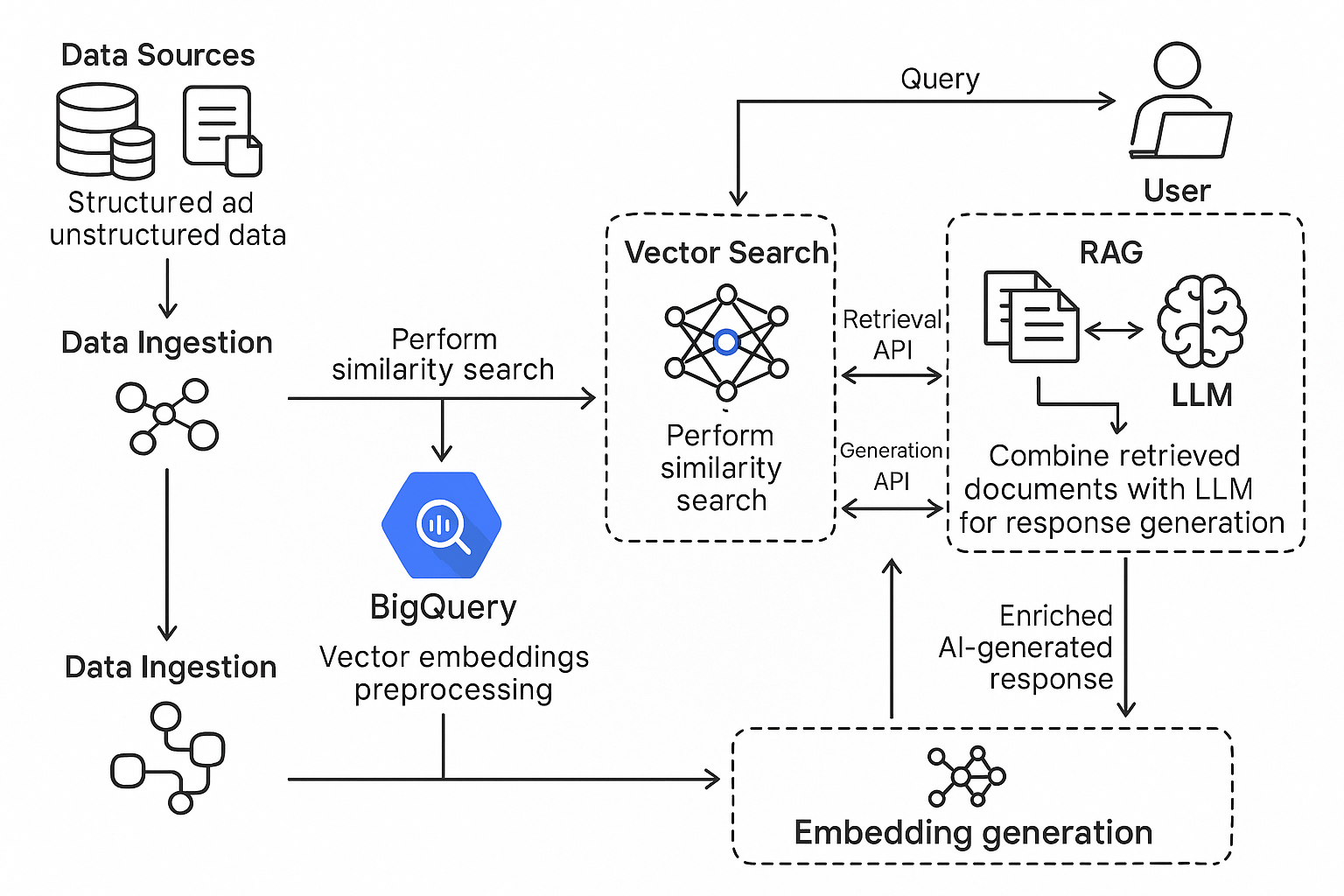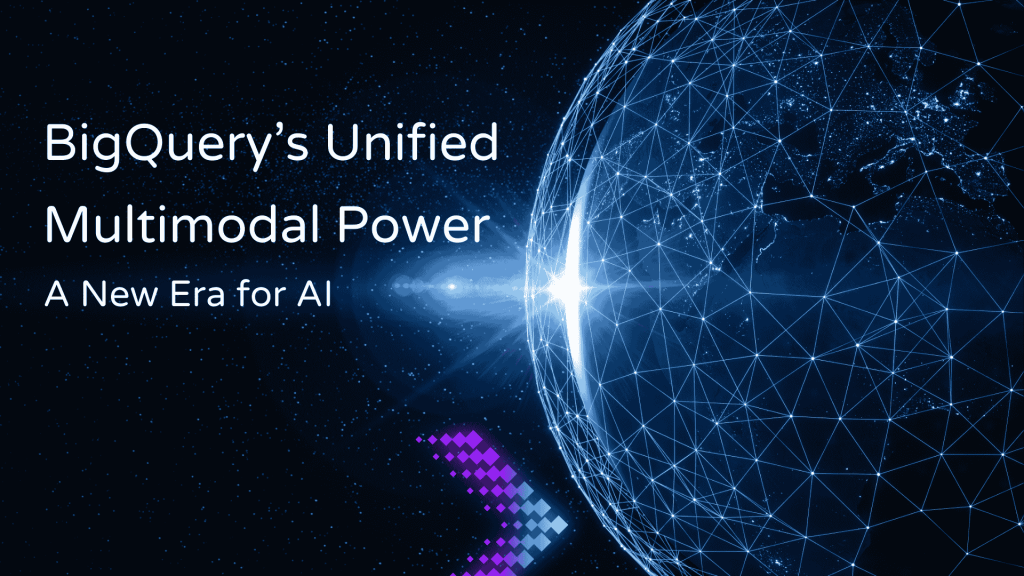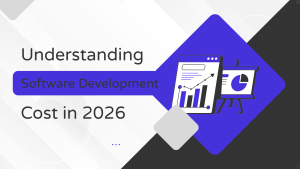Introduction
Welcome to a new time for artificial intelligence. Right now, the world moves fast, and data is important to everyone. But sometimes, data can be hard to keep in order. Google Cloud’s BigQuery helps you handle this. BigQuery is a unified platform, so you can work with your data and artificial intelligence in one place. It does more than just keep your information safe. It helps you get the most out of it. BigQuery works with many data types with ease. So, it lets you use data analytics and come up with new ideas that were not possible before. This platform helps all of us work better with data and AI.
The Rise of Multimodal AI in BigQuery
The world of data is changing and is no longer only text and numbers. Now, there are images, audio files, and other types of important documents. Multimodal AI in Google BigQuery lets you use all these kinds of data in one place. This change is helping businesses on Google Cloud make better use of data analytics. It lets people move away from using many different data platforms and brings everything together in one easy solution.
By using generative AI right where your data is, you do not need to spend time or money moving the information to new places. This united way helps ai work better as it cuts down on slow waiting times, makes daily tasks easier, and lets large language models see good, useful details from many places. In the end, you get faster, more correct, and more helpful answers from your generative AI apps.
👉 Related: How Techwink builds AI-powered solutions
Understanding Multimodal AI: More Than Just Text and Images
So, what is multimodal AI? It is a kind of artificial intelligence that can look at and understand more than one type of data at the same time. For example, people see, hear, and read things to understand what happens around them. Multimodal AI works in a way that is like this for your data. It uses things like customer call recordings, product images, or PDF reports all together to help you get a better idea of what is going on. This means it can handle different data types at the same time.
Dealing with unstructured data can be tough. The many data types all need different ways to store and manage them. This means your system gets complicated and hard to use. When the data is split up like this, it is hard to see your business as a whole. It also stops you from making smart applications that need to work with everything together.
BigQuery helps you by putting all your data in one place. It uses new things like Object Tables. This lets you work with raw files in an easy way and lets you ask questions or search unstructured data using simple SQL. With BigQuery, it is easy to handle many data types for your AI work. Now you can break barriers and find valuable insights from data that was hard to get before.
Why Unified Data Platforms Are Shaping the Future of AI
Think about what it would be like to put a car together using parts made by different companies. These parts were never meant to fit with one another. A lot of data teams feel this way when they work with several broken-up AI systems. A unified platform, like Google Cloud’s BigQuery, brings all you need into a single data warehouse. This helps the team have a good and smooth place to work where everything fits together and works well.
Working in a single platform brings many great benefits to data teams. It lets businesses use BigQuery and AI together for easier data analysis. When you do this, it means people don’t need to spend time putting together many different services. Using only one platform helps cut down on problems and makes mistakes less common. Your team can get results faster. Instead of working with lots of vendors and technologies, teams can pay attention to what matters the most: getting good value out of their data using a simple platform.
This way of working is changing how AI will be in the future. A unified data platform makes everything easier, from taking in data to using AI to find insights. With this, businesses can do new things faster. They can grow better. It helps them make smart applications in a simple way.
Core Benefits of BigQuery’s Unified AI Architecture
Adopting BigQuery’s unified data architecture can be good for any business. When you use BigQuery AI right with your enterprise data, you do not need many tricky, separate systems. This way helps you get valuable insights more quickly. You do not have to wait for your data to move across several tools. You also avoid paying a lot for extra systems. It’s a simple and strong approach for you to work with your data.
The main benefits of a unified platform are not just about speed or saving money. You also get a safe, strong, and ready-for-the-future place for your AI plans. With it, you can find more insights in your data. This helps you, your team, or anyone in your company to make better choices and get ahead of others. Now, let’s look at how this setup makes analytics easier and helps AI do better.
Streamlined Analytics Across Multiple Data Types
One of the big challenges in data analytics is handling all the different data types. A business will get many kinds of data. The data can be structured tables, or unstructured raw data like PDFs and images in cloud storage. BigQuery helps make this easy. You can use BigQuery to work with and analyze all these formats in one place.
BigQuery makes data preparation simple. You do not need to move your files because it lets you use a clear SQL interface right on top of your raw files. That means you and your data teams can query a PDF or an image file like you do with a regular database table. This is a new and better way to work with every type of data.
This feature helps you do data analysis much faster. You do not have to spend weeks working with big data systems. Now, you can get answers in just a few minutes. By bringing together many data types, BigQuery helps you build a strong base for your data. It lets you use all the data well. You, your team, and other people in your business can know more and make better choices, quickly.
Enhanced Performance for Generative AI Applications
Bringing generative AI and BigQuery together can open up great new chances for your business. You can use artificial intelligence right on your own data, without sending it somewhere else or using outside services. This can make things work faster and with less delay.
Imagine you want to make a chatbot that answers questions using your company’s own papers. With old ways, you move the data to a service that is not inside your company for it to read. But by using BigQuery ML, you can do text generation in your data warehouse with functions like ML.GENERATE_TEXT. This helps you keep the data safe the whole time. Your app also stays quick and ready when people use it with text generation.
This way of handling data helps your generative AI models give better answers that make sense for you. You keep both computer power and information together, so things work quicker and cost less for you. The process is also simpler for people to follow. It gets easier for you to build and grow strong AI tools with generative ai that work well for business. This is how you use data processing to get real value for your work.
Leveraging BigQuery for Advanced Business Intelligence
BigQuery is not only a data warehouse. It is also a strong tool for business intelligence. At Google Cloud Next, many people learned how Google Cloud helps businesses use data analysis and AI together on one platform. This way, companies can connect their data warehouse and use it to find more in their data. With this method, you can discover new things and spot patterns in your data, which might be hard to see otherwise. Using Google Cloud for data discovery opens up more doors and helps you get value from all your information.
By using BigQuery and AI for unified analytics, you can do more than just see dashboards or read reports. You can make new data visualization tools and dig deeper into the data. Things that used to be hard or impossible are now possible. This lets your teams ask bigger things about the data. They can get better answers, which helps with new ideas and growth. So, this way helps break down all those old data walls. Now, let’s see how this works with some real-world examples.
👉 Related: Techwink’s custom enterprise solutions
Unified Analytics: Breaking Down Data Silos
Data silos happen when teams store their data in places that don’t talk to each other. This means information is stuck. Because of this, the data teams often have problems getting all the facts they need in one spot. It messes with day-to-day reports and blocks them from moving ahead with AI use cases. A unified analytics setup in BigQuery is made to help with this. It gathers all your data together in one data warehouse, so everything is easy to see and use.
When your unstructured data and your structured data are together, you can look at both at the same time. This gives you a full view. It helps you find deeper insights and make better choices. For example, you could look at customer feedback from call logs and see how it connects with sales data. This will help you understand what makes people buy something.
Breaking down these silos helps your business work better. You can get clear benefits in how things run each day.
- Reduced Complexity: There is one system to manage. Data teams do not need to look after many tools.
- Improved Collaboration: People use the same data. It helps to keep things clear for all. They are always working from one place.
- Faster Time-to-Insight: All data is easy to get to. People can start looking at it right away. AI models can be trained in less time. Data teams benefit from faster time.
Real-World Success Stories: Industry Case Studies
BigQuery’s unified multimodal AI gives real results that help businesses now. When you have a good data strategy, you can make your data better and create a strong competitive advantage. These industry use cases show what can happen when companies use this approach. You get personalized assessments, better quality assurance, and new ways to work with data. The use cases lead to better data quality and give real value for you, your team, and your business.
One way this can help in real life is by making it easier to handle company info. A business may have lots of FAQs, tech manuals, and support tickets all over the place. With BigQuery, the company can set up a smart system that lets people search for what they need. Now, if an employee asks a question using natural language, the system finds answers from many different documents. Then, it gives a clear, simple answer in steps.
Here are some examples of how people in different businesses use BigQuery’s features:
Industry | Use Case | Business Impact |
|---|---|---|
Human Resources |
Personalized Competence Assessment |
An employee submits a resume (PDF), and the system finds relevant training materials from a knowledge base to generate a personalized career plan. |
Customer Support |
Enterprise Knowledge Management |
An agent asks a natural language question and receives a consolidated answer from FAQs, technical manuals, and past support tickets. |
Manufacturing |
Supply Chain and Quality Assurance |
An engineer uploads an image of a faulty part, and the system uses vector search to find similar historical failures and recommend a repair procedure. |
Unified Governance and Security in BigQuery AI
When you bring all your data together in one place, data governance and data security are even more important. BigQuery AI uses the strong security framework of Google Cloud. This helps keep your data safe with tools like encryption and detailed access control. With this system, you can keep control of your important information. At the same time, your teams get the tools they need to do new things. This is a key way to manage data security and access control with Google Cloud.
Unified governance in BigQuery’s AI features sets the same rules for data management and access across the whole platform. This makes it easier to follow the rules and keeps your data safe, which is important when you want people to trust your AI apps. In the next part, you will see how this makes management easier and helps you stay within the rules.
Simplifying Data Management with Centralized Controls
Handling enterprise data can feel very hard, especially if you have several systems and many data workflows to look after. BigQuery makes the work much easier because it has one place where you can manage everything. You get simple controls to take care of all your data management needs. You can set rules, handle data access, and keep an eye on what is happening with your enterprise data. All this is done from just one spot, so you do not have to move between different tools.
This way of working brings everything together, starting with data preparation and going all the way to analysis. You do not have to set up security rules in many different places. You just make those rules once in BigQuery, and then they work everywhere you need them. This helps make sure things stay the same, which is important to keep AI plans safe and to lower the amount of extra work your teams have to do.
BigQuery gives you one clear way to manage who can see and use your data. This helps make sure the right people get the right data when they need it. It keeps your data safe and also helps make your data workflows better. Your teams can feel sure that they are working in a safe and well-managed place.
Ensuring Compliance and Data Integrity at Scale
For any business, it is very important to follow rules like GDPR and HIPAA. BigQuery offers a single data governance setup to help you do this. You can meet tough standards with less work. By keeping all your data processing in one place, you lower the risk you get from moving data between different places. This also makes it easier to make audit trails.
Making sure your data is correct is a big part of building AI you can trust. Bad data quality can make your models wrong and lead to bad choices for your business. BigQuery has features that help you keep data quality and consistency high across all your datasets. This is the base for any strong quality assurance program.
BigQuery’s way of handling governance helps you build up your AI plans without losing control over security or rules. You can bring in more data and try new use cases. All the time you know your data is safe inside a strong and central system. This helps leaders feel sure when they put money into AI. They know they will keep up with all rules that are needed.
Integrating Vertex AI: Unlocking Next-Level Generative Capabilities
The connection between BigQuery and Vertex AI helps you get more from your Generative AI projects. Vertex AI gives you a set of new machine learning tools. When these tools work with BigQuery, data scientists can use the models right on their data. This can be done without moving away from the platform. The way these tools work together makes things faster for development and makes work easier for people.
This integration helps you make better generative solutions. You can use it if you work with BigQuery DataFrames or run models which have many parts. BigQuery gives you a strong data engine, and Vertex AI gives you smart features for building and running models. The two together make a full answer for your data science work. Now, let’s see how vertex ai and bigquery dataframes work together in real projects.
Working Together: BigQuery and Vertex AI in Practice
BigQuery and Vertex AI work together to help with generative AI tasks. This setup is smooth and made for quick results. Data scientists can work with BigQuery DataFrames, which is easy to use with Python. They use this tool to look at and change data in BigQuery. It all feels simple and natural, and Python code completion helps people work quicker and feel more at home in the process.
Once your data is set, you can use Vertex AI models right in your BigQuery workspace. You just need a simple SQL function to send the data to a strong model like Gemini for things like text generation or studying your data. The results will go straight into your BigQuery table. This makes the data science flow easy and smooth.
This unified platform brings your data storage and machine learning all together in one spot. You do not have to handle the messy parts that normally come with setting things up. Work happens here without delay, and your data is more safe. Your team can spend more time coming up with new AI ideas instead of worrying about how it is all built.
Accelerating AI-Driven Advertising and Marketing Solutions
The advertising and marketing industries are changing fast because of generative AI. Google Cloud is leading the way in this change with BigQuery. BigQuery works as a unified platform for data analysis, making things easier for people in marketing. With BigQuery, you can look at customer behavior, sort your audience, and check how well your campaigns do. You can do all this with more speed and accuracy than ever before.
For example, GrowthLoop’s Compound Marketing Engine was made using BigQuery and runs with Gemini. It lets marketing teams make custom groups of people and plan the steps they take. This helps to deliver the right message to the right person at the right time. It can lead to even more growth as results build up. The platform also gives strong data visualization tools. You can see results as they happen and make changes to your strategies right away.
Here’s how BigQuery’s multimodal AI can help you get more out of your ads:
Hyper-Personalization: Look at a lot of customer data to make ad campaigns that feel made just for them.
Accelerated Insights: Quickly find out which marketing moves are working best and understand the reason for it.
Enhanced Creativity: Use generative ai to help make eye-catching ad text and pictures for many ads at once.
Conclusion
In conclusion, BigQuery gives businesses new ways to use AI with its unified multimodal features. The platform makes the mix of different data types easy. It also helps boost the speed and results for generative applications. BigQuery lets organizations break down data silos, so they can have better information for decisions. These main benefits lead to stronger business intelligence, smooth analytics, and better governance.
The world of AI is quickly changing. Using tools like BigQuery, along with Vertex AI, helps you stay ahead. If you want to see what these new features can do, don’t wait. You can ask for a free demo and find out how BigQuery can change your data strategy.
Contents
Frequently Asked Questions
Most frequent questions and answers
BigQuery can work with many data types. It uses Object Tables to make a clear SQL interface for unstructured data in cloud storage. This lets you look at images, PDFs, and other file types right in BigQuery tables. You also get strong tools like vector search to find patterns or similarities in this kind of data.
The BigQuery AI agent uses Gemini to help you with data analytics. It works like a smart helper. You can use natural language to ask for what you need, and it will make sql queries for you. The agent can take care of routine tasks and make data workflows easier. This means people at any skill level can find what they want, get insights, and work better.
In 2025, you will see some new features in BigQuery. These will help make its generative AI work better. BigQuery ML models will get better too. There will be support for open formats and more. BigQuery will have native support for Apache Iceberg tables. This gives you and other users more flexibility with your data. There will also be new and improved tools. These will help people build autonomous and multimodal AI applications on a unified platform.



